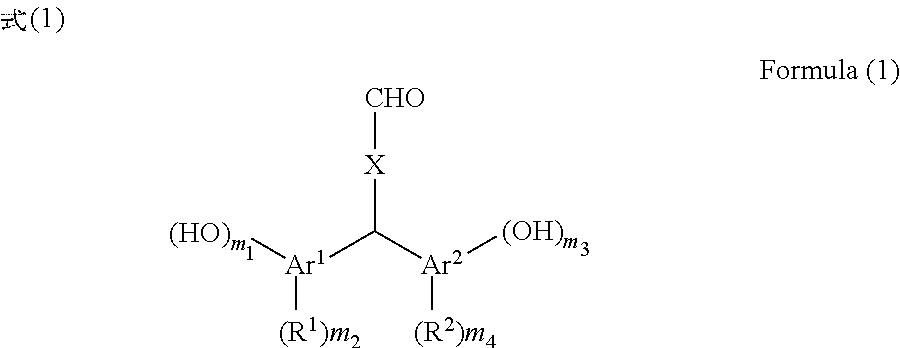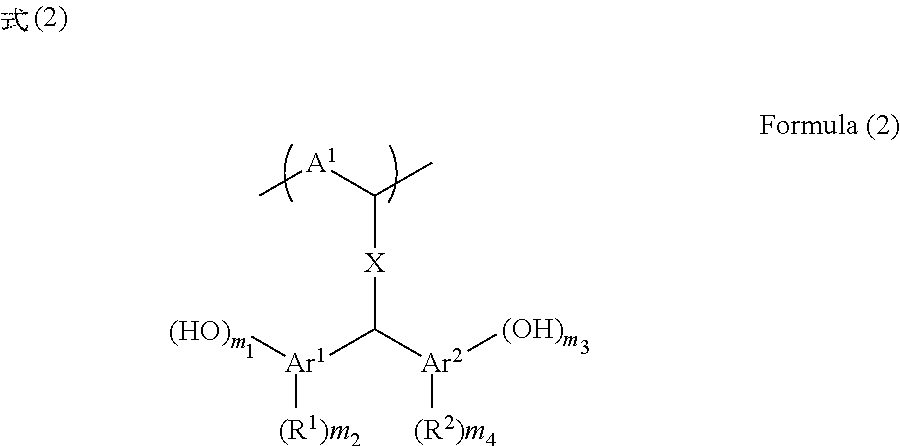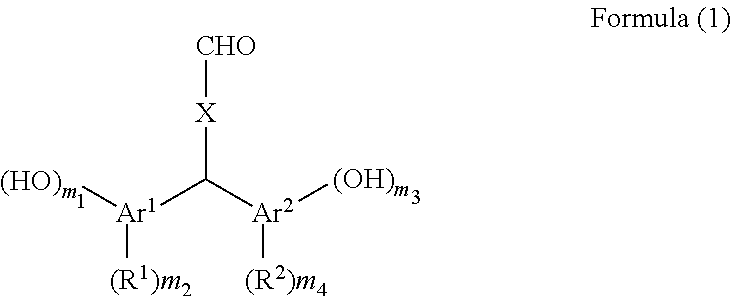Novolac resin-containing resist underlayer film-forming composition using bisphenol aldehyde
- Summary
- Abstract
- Description
- Claims
- Application Information
AI Technical Summary
Benefits of technology
Problems solved by technology
Method used
Image
Examples
synthesis example 1
[0093]150 g of xylene was added to 30.00 g of terephthalaldehyde, 80.54 g of p-cresol, and 8.08 g of p-toluenesulfonic acid monohydrate and the reaction liquid was stirred at 40° C. for 39 hours. After the reaction liquid was cooled, the precipitated crystal was filtered and the crystal was washed with toluene. The obtained crystal was extracted with 2-butanone and washed with pure water, and thereafter the organic phase was dried over sodium sulfate. After the solvent of the organic phase was removed by distillation under reduced pressure, hexane was added to the residue and the mixture was stirred. The precipitated crystal was filtered and the obtained crystal was dried under reduced pressure at 50° C. to obtain 60.07 g (yield 81%) of bis(2-hydroxy-5-methylphenyl)-4-formyltoluene (the compound of Formula (1-1)).
synthesis example 2
[0094]100 g of xylene was added to 25.00 g of terephthalaldehyde, 46.28 g of 4-methylcatechol, and 4.61 g of p-toluenesulfonic acid monohydrate and the reaction liquid was stirred at 40° C. for 60 hours. After the reaction liquid was cooled, the precipitated crystal was filtered and the crystal was washed with toluene. The obtained crystal was extracted with 2-butanone and washed with pure water, and thereafter the organic phase was dried over sodium sulfate. After the solvent of the organic phase was removed by distillation under reduced pressure, hexane was added to the residue and the mixture was stirred. The precipitated crystal was filtered and the obtained crystal was dried under reduced pressure at 50° C. to obtain 55.29 g (yield 81%) of bis(2,3-dihydroxy-5-methylphenyl)-4-formyltoluene (the compound of Formula (1-2)).
synthesis example 3
[0095]100 g of xylene was added to 13.50 g of terephthalaldehyde, 24.59 g of 2,4-dimethylphenol, and 2.49 g of p-toluenesulfonic acid monohydrate and the reaction liquid was stirred at 40° C. for 66 hours. After the reaction liquid was cooled, the precipitated crystal was filtered and the crystal was washed with toluene. The obtained crystal was extracted with 2-butanone and washed with pure water, and thereafter the organic phase was dried over sodium sulfate. After the solvent of the organic phase was removed by distillation under reduced pressure, hexane was added to the residue and the mixture was stirred. The precipitated crystal was filtered and the obtained crystal was dried under reduced pressure at 50° C. to obtain 23.93 g (yield 66%) of bis(2-hydroxy-3,5-dimethylphenyl)-4-formyltoluene (the compound of Formula (1-3)).
PUM
| Property | Measurement | Unit |
|---|---|---|
| Composition | aaaaa | aaaaa |
| Structure | aaaaa | aaaaa |
| Electrical resistance | aaaaa | aaaaa |
Abstract
Description
Claims
Application Information
 Login to View More
Login to View More - R&D
- Intellectual Property
- Life Sciences
- Materials
- Tech Scout
- Unparalleled Data Quality
- Higher Quality Content
- 60% Fewer Hallucinations
Browse by: Latest US Patents, China's latest patents, Technical Efficacy Thesaurus, Application Domain, Technology Topic, Popular Technical Reports.
© 2025 PatSnap. All rights reserved.Legal|Privacy policy|Modern Slavery Act Transparency Statement|Sitemap|About US| Contact US: help@patsnap.com



